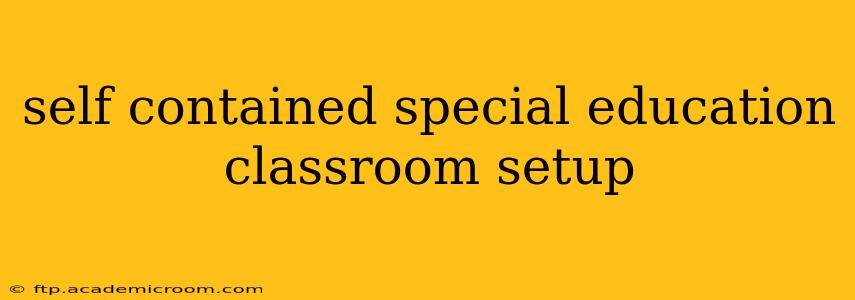Creating a successful self-contained special education classroom requires careful planning and consideration of various factors. This comprehensive guide will delve into the key elements needed to establish a supportive, engaging, and effective learning environment for students with diverse needs. We’ll explore the physical setup, curriculum considerations, and strategies for fostering a positive learning community.
What are the Key Components of a Self-Contained Special Education Classroom?
A self-contained special education classroom differs significantly from a general education classroom. It's designed to cater to the unique needs of students with disabilities who require intensive, individualized instruction and support. Key components include:
- Individualized Education Programs (IEPs): The cornerstone of a self-contained classroom is the IEP, a legally mandated document that outlines each student's specific learning goals, accommodations, and modifications. The classroom's structure, materials, and teaching methods should directly reflect the IEPs.
- Specialized Equipment and Assistive Technology: Depending on students' needs, this could range from adaptive furniture and communication devices to specialized software and sensory tools. The classroom should be equipped to support each student’s individual access to learning.
- Structured Learning Environment: A clear, predictable routine and structured environment are crucial for students who thrive on consistency and predictability. Visual schedules, designated work areas, and clear expectations help to minimize anxiety and maximize learning time.
- Differentiated Instruction: Teachers must be adept at differentiating instruction to meet the diverse needs of students within the classroom. This involves adapting materials, pacing, and teaching strategies to ensure that every student is challenged and supported appropriately.
- Collaboration and Communication: Effective communication with parents, therapists, and other professionals is essential. Regular meetings and progress reports help ensure that the student receives a cohesive and comprehensive education.
How Do I Organize a Self-Contained Special Education Classroom?
The physical layout of the classroom is crucial. Consider these elements:
- Flexible Seating: Provide a variety of seating options, such as chairs, beanbag chairs, wobble stools, and floor cushions, to accommodate different sensory needs and preferences.
- Designated Learning Centers: Create clearly defined areas for different activities, such as reading, writing, art, and sensory exploration. This helps students transition smoothly between activities and understand expectations.
- Quiet Zones: A designated quiet area provides a space for students to escape sensory overload or take a break when needed. This space might include comfortable seating, calming visuals, and noise-reducing materials.
- Accessible Furniture: Ensure all furniture is accessible to students with mobility challenges. Consider adjustable tables and chairs, and ramps or other modifications if needed.
- Visual Supports: Use visual supports such as schedules, charts, and labels to enhance understanding and independence.
What Curriculum Should I Use in a Self-Contained Special Education Classroom?
The curriculum should align with the IEPs of each student. It often incorporates:
- Adaptive Curriculum: This adjusts the curriculum's content, level of difficulty, and delivery methods to match individual student needs.
- Functional Skills Training: This focuses on teaching life skills relevant to students' daily lives, such as personal care, communication, and community participation.
- Assistive Technology Integration: The curriculum should integrate appropriate assistive technologies to maximize student learning and independence.
- Multi-Sensory Learning Activities: Incorporating various sensory modalities (visual, auditory, kinesthetic, tactile) to engage different learning styles.
- Differentiated Instruction Materials: Utilizing a variety of materials and activities tailored to different learning styles and abilities.
What are the Best Practices for Managing Behavior in a Self-Contained Special Education Classroom?
Behavior management in a self-contained classroom requires proactive strategies:
- Positive Behavior Support (PBS): Focus on reinforcing positive behaviors and teaching replacement behaviors for challenging behaviors.
- Visual Schedules and Expectations: Clearly communicate expectations and routines through visual aids.
- Individualized Behavior Plans (IBPs): Develop specific plans to address individual challenging behaviors.
- Consistent Routines and Transitions: Minimize disruptions and transitions by maintaining consistent routines and providing clear signals for transitions.
- Collaboration with Parents and Therapists: Regular communication with parents and other professionals is crucial for consistent behavior management.
What Resources Are Available to Support Self-Contained Special Education Classrooms?
Numerous resources support self-contained special education classrooms, including:
- Local Educational Agencies (LEAs): LEAs provide specialized services, resources, and support for students with disabilities.
- State Departments of Education: State education agencies provide guidance, curriculum frameworks, and professional development opportunities.
- Professional Organizations: Organizations such as the Council for Exceptional Children (CEC) offer resources, training, and advocacy for special education professionals.
By thoughtfully addressing each of these aspects, educators can create a self-contained special education classroom that is both supportive and engaging, fostering the academic and personal growth of students with diverse needs. Remember that flexibility and ongoing assessment are key to success in this dynamic setting.
